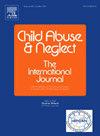Association between adverse childhood experiences and menstruation-related symptoms among Japanese female workers: A cross-sectional study
IF 3.4
2区 心理学
Q1 FAMILY STUDIES
引用次数: 0
Abstract
Backgrounds
Menstruation-related symptoms are a common and serious health problem even without a specific diagnosis such as premenstrual dysphoric mood disorder (PMDD) or dysmenorrhea. Various adverse childhood experiences (ACEs) might be associated with menstruation-related symptoms, not only traditional traumatic events such as abuse, but also expanded ACEs such as childhood poverty, school bullying, or natural disasters.
Objective
This study examined the association between expanded ACEs (ACEs for Japanese) and menstruation-related symptoms among Japanese working women.
Methods
Data came from an online survey conducted in October 2023 that included women aged 20–44 working full-time, who have never been pregnant and are not currently using contraception. Menstruation-related symptoms severity was evaluated using the Menstrual Distress Questionnaire (MDQ) and the Premenstrual Dysphoric Disorder (PMDD) scale. The MDQ score of the premenstrual and menstrual phases were classified into four categories as menstrual symptoms severity of each phase. Logistic regression assessed the association between ACEs and each outcome, adjusting for covariates.
Results
The analysis included 2000 women. Premenstrual and menstrual symptoms severity increased with two or more ACEs. In the fully adjusted model, women with four or more ACEs significantly showed severe premenstrual symptoms (adjusted odds ratio [aOR] = 2.81, 95%CI:2.12–3.72), and severe menstrual symptoms (aOR = 3.03, 95%CI: 2.29–4.02). Four or more ACEs were associated with PMDD (aOR = 5.61, 95%CI: 2.65–11.89). Childhood poverty and school bullying were also associated with menstruation-related symptoms severity, and natural disasters with PMDD.
Conclusions
Expanded ACEs were associated with menstruation-related symptoms. The results suggested the importance of trauma-informed care in gynecology, obstetrics, and occupational health practice.
日本女工不良童年经历与月经相关症状之间的关系:一项横断面研究
背景:月经相关症状是一种常见且严重的健康问题,即使没有特定的诊断,如经前烦躁情绪障碍(PMDD)或痛经。各种不良童年经历(ace)可能与月经相关症状有关,不仅包括传统的创伤性事件,如虐待,还包括扩大的ace,如童年贫困、学校欺凌或自然灾害。目的:本研究探讨日本职业女性ace扩大与月经相关症状之间的关系。方法:数据来自于2023年10月进行的一项在线调查,调查对象是年龄在20-44岁之间的全职工作女性,她们从未怀孕过,目前也没有采取避孕措施。使用月经困扰问卷(MDQ)和经前烦躁不安(PMDD)量表评估月经相关症状的严重程度。经前期和经期的MDQ评分根据各期的月经症状严重程度分为四类。逻辑回归评估了ace与每个结果之间的关系,并对协变量进行了调整。结果:该分析包括2000名女性。经前和经期症状严重程度随着两次或两次以上ace而增加。在完全调整的模型中,四次及以上ace的女性显著表现出严重的经前症状(调整优势比[aOR] = 2.81, 95%CI:2.12-3.72)和严重的月经症状(aOR = 3.03, 95%CI: 2.29-4.02)。4例及以上ace与PMDD相关(aOR = 5.61, 95%CI: 2.65 ~ 11.89)。童年贫困和学校欺凌也与月经相关症状的严重程度以及自然灾害与经前不悦症有关。结论:ace扩大与月经相关症状相关。结果提示创伤知情护理在妇科、产科和职业卫生实践中的重要性。
本文章由计算机程序翻译,如有差异,请以英文原文为准。
求助全文
约1分钟内获得全文
求助全文
来源期刊

Child Abuse & Neglect
Multiple-
CiteScore
7.40
自引率
10.40%
发文量
397
期刊介绍:
Official Publication of the International Society for Prevention of Child Abuse and Neglect. Child Abuse & Neglect The International Journal, provides an international, multidisciplinary forum on all aspects of child abuse and neglect, with special emphasis on prevention and treatment; the scope extends further to all those aspects of life which either favor or hinder child development. While contributions will primarily be from the fields of psychology, psychiatry, social work, medicine, nursing, law enforcement, legislature, education, and anthropology, the Journal encourages the concerned lay individual and child-oriented advocate organizations to contribute.
 求助内容:
求助内容: 应助结果提醒方式:
应助结果提醒方式:


